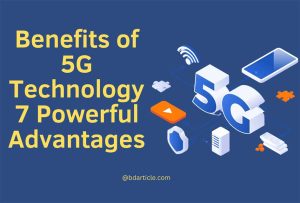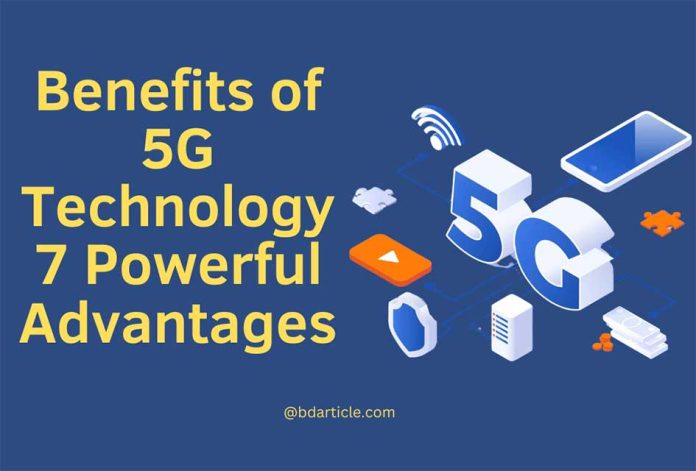The benefits of 5G technology are transforming the way we live, work, and connect. As the fifth generation of wireless technology, 5G is not just an upgrade from 4G but a revolutionary leap that promises faster speeds, lower latency, and a more connected world. From enhancing mobile experiences to enabling groundbreaking advancements in industries like healthcare, transportation, and manufacturing, 5G is poised to redefine the future. In this piece, we will explore seven powerful advantages of 5G technology, its features, and how it compares to previous generations. We will also touch on some challenges, such as the disadvantages of 5G technology and its environmental impact.

Faster Speeds and Enhanced Connectivity
One of the most significant benefits of 5G technology is its incredible speed. 5G networks can deliver download speeds up to 10 gigabits per second, which is 100 times faster than 4G. This means you can download a full-length HD movie in seconds, stream high-quality videos without buffering, and enjoy seamless online gaming experiences. Faster speeds also enhance connectivity in crowded areas like stadiums, airports, and urban centres, where 4G networks often struggle to keep up.
The features of 5G technology include advanced antenna technologies and higher frequency bands, which contribute to its superior performance. These features enable 5G to handle more devices simultaneously, making it ideal for the growing number of smart devices and applications. For those interested in a deeper dive, you can find detailed explanations in the benefits of 5G technology PDF or features of 5G technology PDF.
Lower Latency for Real-Time Applications
Latency refers to the time it takes for data to travel from one point to another. 5G technology reduces latency to as low as 1 millisecond, compared to 30-50 milliseconds on 4G networks. This near-instantaneous communication is crucial for applications that require real-time responses, such as autonomous vehicles, remote surgery, and Augmented Reality (AR) experiences.
For example, in the healthcare industry, surgeons can perform remote surgeries using robotic arms controlled through 5G networks. The low latency ensures that there is no delay between the surgeon’s actions and the robot’s movements, making such procedures safer and more reliable. Similarly, autonomous vehicles rely on 5G’s low latency to communicate with each other and traffic systems, reducing the risk of accidents.
Greater Capacity for IoT and Smart Devices
The Internet of Things (IoT) examples are everywhere, from smart home devices like thermostats and security cameras to industrial sensors and wearable health monitors. 5G technology is designed to support the massive number of connected devices that make up the IoT ecosystem. With its greater capacity, 5G can handle up to a million devices per square kilometre, far surpassing the capabilities of 4G.
This increased capacity is essential for smart cities, where thousands of sensors and devices work together to optimize traffic flow, reduce energy consumption, and improve public safety. In manufacturing, 5G enables the use of smart factories, where machines and robots communicate seamlessly to increase efficiency and reduce downtime.
Improved Energy Efficiency
Another benefit of 5G technology is its improved energy efficiency. While 5G networks require more energy to operate due to their advanced infrastructure, they are designed to be more efficient per unit of data transmitted. This means that 5G can deliver more data while consuming less power compared to 4G.
Energy efficiency is particularly important for IoT devices, many of which rely on batteries. With 5G, these devices can operate longer without needing frequent recharging or battery replacements. This not only reduces maintenance costs but also contributes to sustainability efforts.
Enhanced Mobile Experiences
5G technology is set to revolutionize mobile experiences by enabling new applications and services that were not possible with 4G. For instance, augmented reality (AR) and virtual reality (VR) applications will become more immersive and responsive, thanks to 5G’s high speeds and low latency. Imagine attending a live concert from the comfort of your home, with a VR headset providing a 360-degree view of the stage and real-time interactions with other attendees.
5 G will also benefit mobile gaming, as players can enjoy cloud-based games without worrying about lag or performance issues. Additionally, 5G will enable more personalized and interactive content, such as AI-driven recommendations and real-time language translation during video calls.
Advantages of 5G Over 4G
The advantages of 5G over 4G are clear. While 4G brought us faster mobile internet and enabled the rise of streaming services, 5G takes connectivity to a whole new level. As mentioned earlier, 5G offers significantly faster speeds, lower latency, and greater capacity. These improvements open up new possibilities for innovation and productivity across various sectors.
For businesses, 5G means faster data transfer, improved remote work capabilities, and the ability to leverage advanced technologies like AI and machine learning. For consumers, it means better entertainment options, smarter homes, and more reliable communication.
Challenges and Disadvantages of 5G Technology
While the benefits of 5G technology are undeniable, it is important to acknowledge some of its challenges and disadvantages. One major concern is the cost of deploying 5G infrastructure. Building the necessary network of small cells, towers, and fibre-optic cables requires significant investment, which can be a barrier for some regions.
Another challenge is the limited range of 5G signals, especially when using higher frequency bands. This means that more infrastructure is needed to ensure consistent coverage, particularly in rural areas. Additionally, there are concerns about the disadvantages of 5G on the environment, such as the energy consumption of 5G networks and the potential impact of electromagnetic radiation.
Despite these challenges, the benefits of 5G technology far outweigh the drawbacks. With continued investment and innovation, these issues can be addressed, paving the way for a more connected and efficient future.
Conclusion
The benefits of 5G technology are vast and transformative. It offers faster speeds, lower latency, greater capacity, and improved energy efficiency. From enhancing mobile experiences to enabling groundbreaking advancements in industries like healthcare and transportation, 5G is set to revolutionize the way we live and work. While there are challenges to overcome, such as the cost of infrastructure and environmental concerns, the potential of 5G is undeniable.
As we continue to explore the features of 5G technology and its applications, it is clear that 5G is not just an upgrade but a game-changer. Whether you are a Business Looking to leverage new technologies or a consumer seeking better connectivity, the benefits of 5G technology are worth embracing. For more detailed insights, you can refer to a benefits of 5G technology PDF or a features of 5G technology PDF, which provide comprehensive information on this groundbreaking technology.

